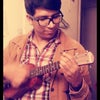The Dome of the Rock (Arabic: مسجد قبة الصخرة, translit.: Masjid Qubbat As-Sakhrah, Hebrew: כיפת הסלע, translit.: Kipat Hasela) is an Islamic shrine which houses the Foundation Stone, arguably the holiest spot in Judaism, and is a major landmark located on the Temple Mount in Jerusalem. It was completed in 691, making it the oldest extant Islamic building in the world. Its significance stems from the religious beliefs regarding the rock at its heart.
The Dome of the Rock is located at the center of a platform known as the Temple Mount, which Muslims refer to as the "Noble Sanctuary". It was constructed over the site of the Second Jewish Temple which was destroyed during the Roman Siege of Jerusalem in 70 CE. In 637 CE, Jerusalem was conquered by the Rashidun Caliphate army during the Islamic invasion of the Byzantine Empire.
The Dome of the Rock was erected between 685 and 691 CE. The names of the two engineers in charge of the project are given as: Yazid Ibn Salam from Jerusalem and Raja Ibn Haywah from Baysan. Umayyad Caliph Abd al-Malik ibn Marwan who initiated construction of the Dome, hoped that it would “house the Muslims from cold and heat” and intended the building to serve as a shrine for pilgrims and not as a mosque for public worship. Historians contend that the Caliph tried to create a structure which would compete with the existing buildings of other religions in the city.
was the first westerner known to have made detailed drawings of the Dome, which he accomplished during a six-week period in 1833)]]
Prof. Shlomo Dov Goitein of the Hebrew University states that the Dome of the Rock was intended to compete with the many fine buildings of worship of other religions. The very form of a rotunda, given to the Qubbat as-Sakhra, although it was foreign to Islam[], attempted to rival the many Christian domes of its time. A.C. Cresswell in his book Origin of the plan of the Dome of the Rock notes that those who built the shrine used the measurements of the Church of the Holy Sepulchre. The diameter of the dome of the shrine is 20m 20 cm and its height 20m 48 cm, while the diameter of the dome of the Church of the Holy Sepulchre is 20m 90 cm and its height 21m 5 cm.
The structure is basically octagonal. It comprises a wooden dome, approximately 60 feet (20 m) in diameter, which is mounted on an elevated drum consisting of a circle of 16 piers and columns. Surrounding this circle is an octagonal arcade of 24 piers and columns. During his travels in Jerusalem, Mark Twain wrote that:
”Every where about the Mosque of Omar are portions of pillars, curiously wrought altars, and fragments of elegantly carved marble - precious remains of Solomon's Temple. These have been dug from all depths in the soil and rubbish of Mount Moriah, and the Moslems have always shown a disposition to preserve them with the utmost care.”
The outer side walls are made of porcelain and mirror the octagonal design. They each measure approximately 60 feet (18 m) wide and 36 feet (11 m) high. Both the dome and the exterior walls contain many windows.
The Dome is in the shape of a Byzantine martyrium, a structure intended for the housing and veneration of saintly relics, and is an excellent example of middle Byzantine art. al-Maqdisi reports that surplus funds consisting of 100,000 gold dinar coins were melted down and cast on the dome's exterior, “which at the time had a strong glitter that no eye could look straight at it.” During the reign of Suleiman the Magnificent the exterior of the Dome of the Rock was covered with Iznik tiles. The work took seven years. Haj Amin Al-Husseini, appointed Grand Mufti by the British, along with Yacoub Al Ghussein implemented restoration of Dome of the Rock and Al Aqsa Mosque in Jerusalem.
In 1955 an extensive program of renovation was begun by the government of Jordan, with funds supplied by the Arab governments and Turkey. The work included replacement of large numbers of tiles dating back to the reign of Suleiman the Magnificent, which had become dislodged by heavy rain. In 1960, as part of this restoration, the dome was covered with a durable aluminum and bronze alloy made in Italy. The restoration was completed in August 1964. In 1998 the golden dome covering was refurbished following a donation of $8.2 million by King Hussein of Jordan who sold one of his houses in London to fund the 80 kilograms of gold required.
InteriorThe interior of the dome is lavishly decorated with mosaic, faience and marble, much of which was added several centuries after its completion. It also contains Qur'anic inscriptions. Sura Ya-Seen is inscribed across the top of the tile work and was commissioned in the 16th century by Suleiman the Magnificent. Al-Isra is inscribed above this.
According to Prof. Shlomo Dov Goitein, the inscriptions decorating the interior clearly display a spirit of polemic against Christianity, while stressing at the same time the Qur'anic doctrine that Jesus Christ was a true prophet. The formula la sharika lahu 'God has no companion' is repeated five times, the verses from Sura Maryam 19:34-37, which strongly reaffirm Jesus' prophethood to God, are quoted together with the prayer: Allahumma salli ala rasulika wa'abdika 'Isa bin Maryam - "In the name of the One God (Allah) Pray for your Prophet and Servant Jesus son of Mary". He believes that this shows that rivalry with Christendom, together with the spirit of Islamic mission to the Christians, was at the work at the creation of the famous Dome.
During the Crusades the Dome of the Rock was given to the Augustinians, who turned it into a church, and the Al-Aqsa Mosque became the royal palace of Baldwin I of Jerusalem in 1104. The Knights Templar, who believed the Dome of the Rock was the site of the Temple of Solomon, set up their headquarters in the Al-Aqsa Mosque adjacent to the Dome for much of the 12th century. The "Templum Domini," as they called it, was featured on the official seals of the Order's Grand Masters (such as Evrard de Barres and Regnaud de Vichier), and it became the architectural model for Templar churches across Europe.
Jerusalem was recaptured by Saladin on Friday, 2 October 1187 and the Haram was reconsecrated as a Muslim sanctuary. The cross on top of the Dome of the Rock was replaced by a golden crescent and a wooden screen was placed around the rock below. Salah al-Din's nephew al-Malik al-Mu'azzam Isa (615-24/1218-27) carried out other restorations within the Haram and added the porch to the Aqsa mosque.
The Haram was the focus of extensive royal patronage by the sultans during the Mamluk period, which lasted from 1250 until 1510.
's Cotton Gate (Bab al-Qattanin)]] Large-scale renovation was undertaken during the reign of Mahmud II in 1817. Adjacent to the Dome of the Rock, the Ottomans built the free-standing Dome of the Prophet in 1620.
The Dome of the Rock was badly shaken during an earthquake in Palestine on Monday, 11 July 1927 rendering useless many of the repairs that had taken place over previous years.
Under Jordanian rule of Jerusalem, Jews were forbidden from entering the Old City. Israel took control of the Dome of the Rock during its victory in the Six-Day War in 1967. Shlomo Goren also entered the Dome of the Rock with a Torah book and the shofar.
A few hours after the Israeli flag was hoisted over the Dome of the Rock in 1967, at the conclusion of the Six-Day War, Israelis lowered it on the orders of General Moshe Dayan, and invested the Muslim Waqf (religious trust) with the authority to manage the Temple Mount-Haram al-Sharif in order to "keep the peace".
Groups such as the Temple Mount and Eretz Yisrael Faithful Movement wish to relocate the Dome to Mecca and replace it with a Third Temple. Since Muslim religious foundations own the Dome and consider it particularly sacred such actions would inevitably lead to violence. Many Israelis are ambivalent about the movement's wishes. Some religious Jews, following a rabbinic dictum, feel that the Temple should only be rebuilt in the messianic era, and that it would be presumptuous of people to force God's hand. However, some Evangelical Christians consider this a prerequisite to Armageddon and the Second Coming. This view is steeped in the belief that there will be a prophetic rebuilding of the Temple in place of the Dome of the Rock.
The Dome of the Rock is depicted on the reverse of the Iranian 1000 rials banknote.
It is maintained by the Ministry of Awaqaf in Jordan.
Until the mid-nineteenth century, non-Muslims were not permitted in the area. Since 1967, non-Muslims have been permitted limited access, however non-Muslims are not permitted to pray on the Temple Mount.
In 2006, the compound was reopened to non-Muslim visitors between the hours of 7:30-11:30 a.m. and 1:30-2:30 p.m. during Summer and 7:30-10:30 a.m. and 1:30-2:30 p.m. during Winter. Non-Muslims are prohibited from entering after 2:30 p.m. and may not enter on Fridays, Saturdays, or Muslim holidays. Entry is through a wooden walkway next to the entrance to the Hebrew Western Wall. Non-Muslims are prohibited from entering the mosques and accessing the Temple Mount through the Cotton Market. Visitors are subject to strict security screening, and items such as Jewish prayerbooks and instruments are prohibited.
Many Orthodox rabbis regard the rules of entry to the compound to be a violation of Jewish law. This is based on the belief that since the time the Temple was destroyed during the siege of Jerusalem in 70 CE, the precise location of the Holy of Holies, the sanctuary entered only by the High Priest, is not known. Hence a restriction applies to the entire compound. However, other rabbis believe that modern archeological and other evidence has enabled them to identify areas that can be safely entered without violating Jewish law.
, viewed from the Dome.]]
The Dome of the Rock, being among a complex of buildings on the Temple Mount, (the other principal building being the Al-Aqsa Mosque) is one of the holiest sites in Islam, following Mecca and Medina. Its significance stems from the religious beliefs regarding the rock at its heart. According to Islamic tradition, the rock is the spot from where Muhammad ascended to Heaven accompanied by the angel Gabriel.
The stone over which the Muslim shrine, the Dome of Rock, was built is the holiest site in Judaism. Jews have traditionally regarded the location of the stone as the holiest spot on Earth, the site of the Holy of Holies during the Temple Period. In former times, some Jewish scholars thought that the location of the Holy of Holies was not known for certain. Today this is a minority opinion.
Just as Muslims pray towards the Kaaba at Mecca, the holiest site in Islam, Jews pray towards the site of the ancient Holy of Holies, the Foundation Stone, the holiest site in Judaism.
The most propitious site for Jewish prayer is that spot that is nearest the Foundation Stone. Because Muslim authorities refused to permit Jewish prayer on the Temple Mount, the custom developed of praying near the Western Wall, since it was the site nearest to the Foundation Stone, or on the Mount of Olives facing the site of the Temple. Between 1948 and 1967, when Jordanian authorities refused permission to Jews to enter the Old City of Jerusalem, Jews made pilgrimages to rooftops on Mount Zion and prayed towards the site of the ancient Holy of Holies. .]] In Christianity it is believed that during the time of the Byzantine Empire, nearby the spot where the Dome was later constructed was where Constantine's mother built a small church, calling it the Church of St. Cyrus and St. John, later on enlarged and called the Church of the Holy Wisdom. On the walls of the Dome of the Rock is an inscription in a mosaic frieze that includes the following words:
"Bless your envoy and your servant Jesus son of Mary and peace upon him on the day of birth and on the day of death and on the day he is raised up again. It is a word of truth in which they doubt. It is not for God to take a son. Glory be to him when he decrees a thing he only says be, and it is."The date recorded as 72 after the Hijra (or 691-692 CE), which historians view as the year of the Dome's construction.
shows the Temple at Jerusalem depicted in the shape of the Dome of the Rock.]] A number of buildings have been designed as copies of the Dome of the Rock. These include the octagonal Church of St. Giacomo in Italy, and the octagonal, Moorish Revival style Rumbach Street synagogue in Budapest. This was done because Dome of the Rock itself was long believed by Christians and Jews to echo the architecture of the Temple in Jerusalem, as can be seen in Raphael's The Marriage of the Virgin and in Perugino's Marriage of the Virgin.





